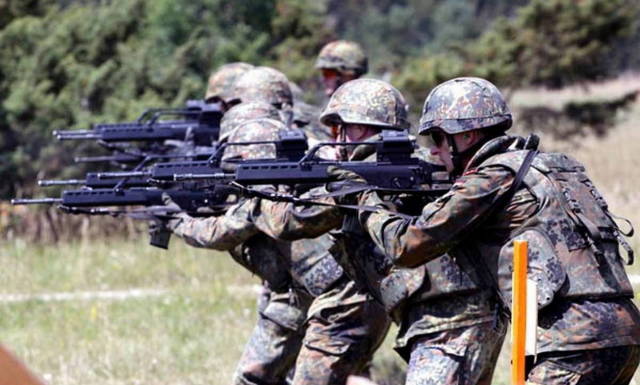Over the past decade, the fire training of the German Armed Forces has undergone significant changes. It should be noted that similar processes regarding the methods of possession and use of small arms and anti-tank weapons take place in other NATO countries. In this regard, a more detailed consideration of the new approach adopted in the Bundeswehr is of some interest.
A new concept of fire training of German Armed Forces personnel in shooting from personal and hand-held anti-tank weapons (neues Schiessausbildungskonzept, nSAK) signed by the Inspector General of the Bundeswehr on August 17, 2010. In accordance with the general plans for the construction of the armed forces, its introduction into the troops was completed at the turn of 2014-15 . The document was aimed at adapting the fire training of troops to the new changed conditions and operational requirements.
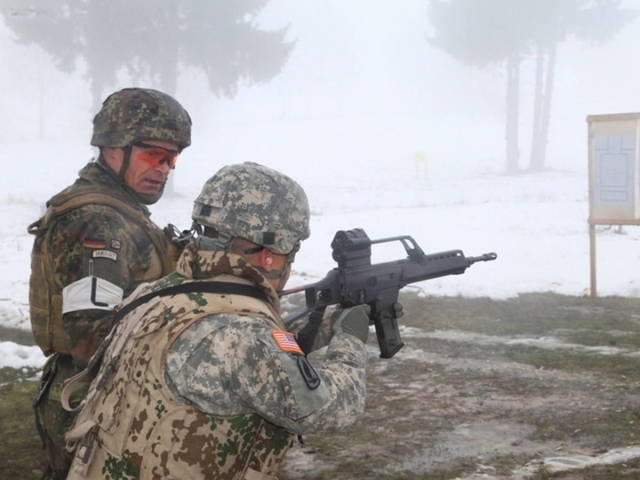
Study of the new Bundeswehr methodology by the US military
Fire training of military personnel – justification of changes
According to the views of the Bundeswehr command, the previously adopted method of fire training originated in the Cold War and no longer meets modern realities. It was intended for the army, whose main task was the defense of the country. Given the nature of such a battle, the main defeat of the enemy was envisaged to be inflicted at a direct shot range of up to 300m.
These conditions have changed significantly since 1990. Conflict prevention and crisis management became the leading area of Bundeswehr operations. As an example, the ISAF contingent in Afghanistan or KFOR forces in the Balkans. In such missions, the main enemy was not so much the soldiers of the enemy army as the militants of an irregular formation. The nature of their actions, as a rule, is secretive, in settlements, from a close distance.
The reality of modern combat has become densely populated urban areas where military targets are mixed with civilians (non-combatants). As a result, the range of use of personal weapons has been completely updated and significantly expanded. Success in battle, as never before, began to depend on the skills and training of an individual soldier.

Working out actions in a locality
Fire training of military personnel as a discipline
in accordance with the provisions of the new concept, personal weapons should be used at various distances. All firing ranges are considered equivalent in their value. However, now in the course of training, special priority is given to the melee distance. Only when dominating at all ranges in numerous possible scenarios is a soldier able to use his personal weapon safely and effectively.
Fire training of military personnel, according to the new concept, has acquired a modular character. It has an increasing complexity and allows you to take into account the peculiarities of the combat use of the armed forces and services. Structurally, the discipline is divided into general basic training (Grundlagenausbildung) and full training (Vollausbildung).
General basic training includes the following modules:
- initial training;
- short-range shooting, part I (Nahbereichsschießen, Teil I);
- firing by the sentry (Wachschießen).
Subsequent full training includes modules:
- basic training in an additional category of weapons (Grundlagenausbildung an weiteren Waffen);
- shooting at close range, part II;
- shooting single shooters (Schießen des Einzelschützen);
- firing at aerial targets (Fliegerabwehrschießen);
- specific shooting training (Spezifische Schießausbildung);
- shooting at close range, part III;
- shooting in special conditions (Besondere Lagen);
- confirmation of shooting skill (Erhalt der Schießfertigkeit).
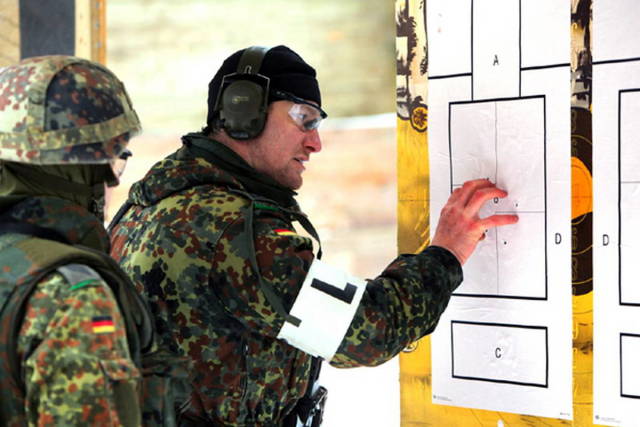
Evaluation of shooting results
Features of the methodology
The concept includes significant innovations that are considered to be of key importance. In particular, during the entire course, short-range shooting (3 - 30m) is practiced. This module of which consists of three parts.
Special attention is paid to the personal responsibility of military personnel. They are instilled with "four basic safety rules". The rules require continuous monitoring of the condition of personal weapons (magazine, chamber, sight and barrel) and its readiness to fire. Military personnel must act independently and be responsible for their personal combat readiness. So, the soldier immediately receives the full amount of ammunition for the entire training day. In the future, he is obliged to evaluate the required number of cartridges and control their consumption. Equip the stores yourself based on the upcoming exercises.
Organizationally, as stated, the concept united teachers and instructors of fire training, reduced the number of service personnel, increased the practical training of personnel. In addition, there was a separation of the assessment of shooting and the amount of spent ammunition.
Content of modules
As a first step, basic training is aimed at training soldiers in the safe handling of personal small arms (rifles and pistols) and hand-held anti-tank weapons. At this stage, the safety rules are studied, and enhanced training of exercises with weapons is carried out. The purpose of the training is to lay the foundation for its application in the following sections of fire training.

Exercise with weapons under the guidance of an instructor
Both at the stage of basic training and in the future, shooting simulators are actively used.
Shooting at close range As mentioned above, the module consists of three parts. In the first part, shooting with a single and double shot, the position of the body when shooting (the so-called "patrol position" is being worked out), the reaction to the threat in the absence of direct impact, the defeat of various targets.
The second part of the module includes: working out the position of the body in the "combat position", turns with weapons at 90 and 180 degrees, shooting in motion.
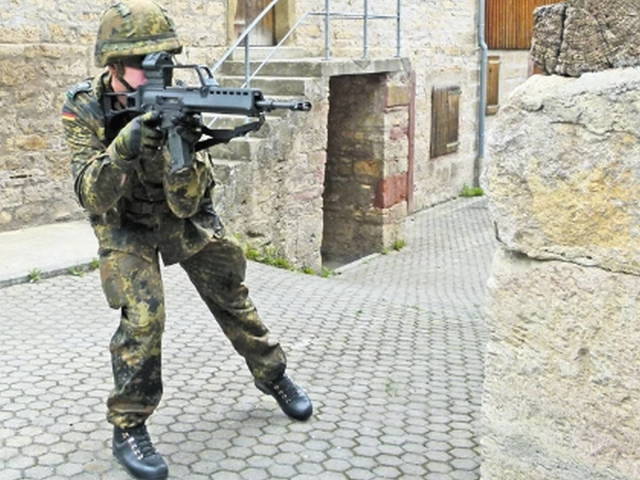
Working out the "combat position"
The final third part includes methods of disguise, techniques for changing the type of weapon, hitting moving targets, training in changing the production. As a result, the module is designed to achieve automatism of the actions of trainees with weapons and increase their reaction to a sudden change in the situation.
According to the regulations, a trained soldier should spend up to 2 seconds. for two accurate shots at the target at a range of 5 m and no more than 3 seconds – at a range of 10-15m.
Shooting single shooters and other Module reinforces melee skills. The exercises are conducted against the background of a tactical situation. Military personnel consolidate their individual skills as part of units, in full equipment.
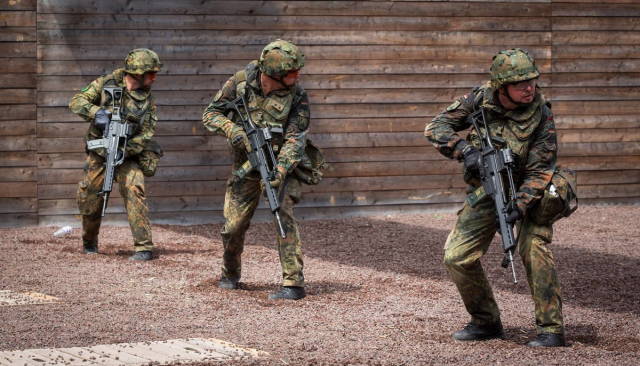
Actions as part of a group
The defeat of targets at a direct shot range and a longer distance is practiced in the modules "Specific shooting training" and "Shooting in special conditions". In particular, the "specific" refers to the training of snipers and other specialists. Combat firing of units is carried out in these modules.
"Shooting in special conditions" is intended primarily for units and formations sent on foreign business trips. Military personnel are trained according to the upcoming actions. As an element, for example, the firing of their combat vehicles is practiced in the process of patrolling.
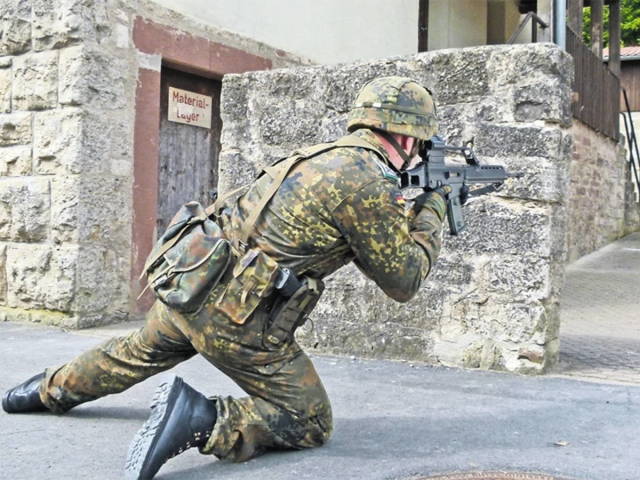
Shooting techniques based on the experience of Afghanistan
The module "Confirmation of shooting skills" is aimed at assessing the shooting skills of military personnel who have completed a full course of training. In addition, the module is designed to maintain the training of personnel at the proper level. It includes mandatory testing of shooting skills with the help of various exercises, as well as an assessment of shooting accuracy.
Every Bundeswehr soldier must complete the module at least once a year. The difficulty of the exercises is determined by teachers or instructors in shooting training.
Progress of the reform
The introduction of the principles of the new concept into the troops posed a number of challenges to the Bundeswehr command. Overcoming them determined the final result of the transition to a new method of fire training.
At the initial stage, it was necessary to solve the personnel shortage of professional fire training teachers and shooting instructors in a short time. Their qualification under the new concept began in 2011. Decentralized in educational institutions for officers and non-commissioned officers. At the end of the qualification courses, newly trained teachers were sent to the troops.
The introduction of the new methodology was carried out primarily as part of the ongoing training of troops or preparation for a specific mission abroad. Gradually, the methodology was supplemented in the training of command staff and basic training of military personnel.
At the final stage, the turn of 2014-15, the transformed fire training of military personnel was introduced for the staff of institutions and departments of the Bundeswehr. Currently, the professional training of teachers in shooting for all Armed Forces is carried out centrally on the basis of the infantry training center, Hammelburg (Hammelburg).
Impact on weapons and material support
Intensive shooting training has led to increased ammunition consumption, greater weapon wear and increased use of equipment from the Bundeswehr shooting ranges. In addition, there has been a reassessment of security aspects. In particular – means of protection of the organs of vision and hearing, the use of old-type bullet traps (saturated).
According to published data, the consumption of ammunition mainly for the P8 pistol increased from 10.5 (2009) to 26.3 (2013) million rounds. The consumption for the G36 rifle remained at the level of 29-30.1 million shots. At the same time, on the one hand, there was a transfer of ammunition consumption for the G36 from live firing to training according to the new concept at shooting ranges. On the other hand, in the period between 2009 and 2013, the total number of personnel in the troops decreased while increasing the intensity of single training.
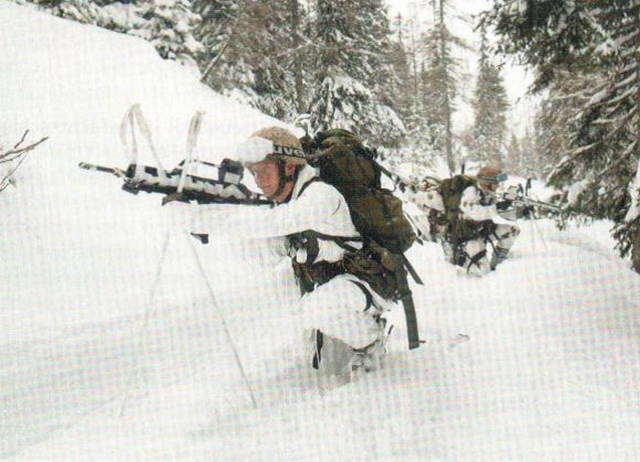
Single rifle training as part of a unit
The consequence of a significant increase in fire loads was a faster achievement of barrel wear limits, especially for the P8 pistol. As a result, parts switched to using its improved version, the P8A1 pistol, with an increased barrel loading characteristic.
The new concept also required the adaptation of the infrastructure for shooting at close range. In particular, bullet traps and fasteners for targets to compensate for the resulting increased load.
Implementation experience
After the signing of the concept, training in new methods became mandatory for military personnel assigned to operations abroad. The existing standards of armament in such operations provide for equipping personnel with primary and secondary weapons.
Based on this, during training, special attention is paid to safe possession and rational use of it at close range. It is reported that the servicemen who have completed training have a significant increase in the level of weapon ownership, independence of actions and "a more subtle sense of the barrel."
At the same time, there were facts of skeptical attitude of a number of commanders to the new methodology. Sometimes this led to attempts by such commanders to avoid training for their units according to the concept.
The main reason for skepticism is the contradiction of the new approach to the classical one, in which the troops are opposed by a "symmetrical" enemy. In this case, they try to destroy the enemy at an average and greater distance, preventing convergence and avoiding their own losses.
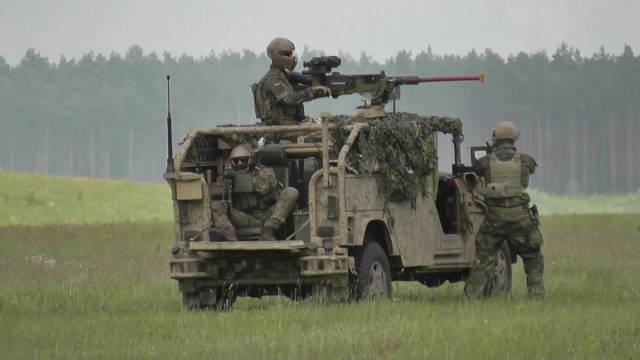
Training at the training ground
In order to overcome the resistance that arose during combat training, such a development of the tactical situation was practiced, which required a "natural" transition to defeating the enemy at close range. The latter was worked out by conducting combat firing units with elements of a new concept.
With the accumulation of experience, changes were made both to the fire training modules and to the training programs for military commanders, teachers and shooting instructors. The graduation of the first pilot course of instructors trained under the extended program (five weeks instead of three) took place in 2014.
Resume
Thus, at the turn of 2014-15, the fire training of Bundeswehr servicemen from personal and anti-tank weapons was reformed according to a new concept. The concept was developed based on the features of the battle, in which an asymmetric opponent is considered as the main one. The new technique has a modular character with a significant bias towards the development of close combat skills at a distance of 3 to 30 m.
It should be noted that, in fact, immediately after that, the NATO countries again started talking about the need to defend the alliance from the army of a symmetrical enemy. The events in the south-east of Ukraine show that the classical approach to combat continues to remain relevant.
Video 2012 Fire training of military personnel within the framework of the new concept:
Based on the materials of the journal "Europäische Sicherheit & Technik"
